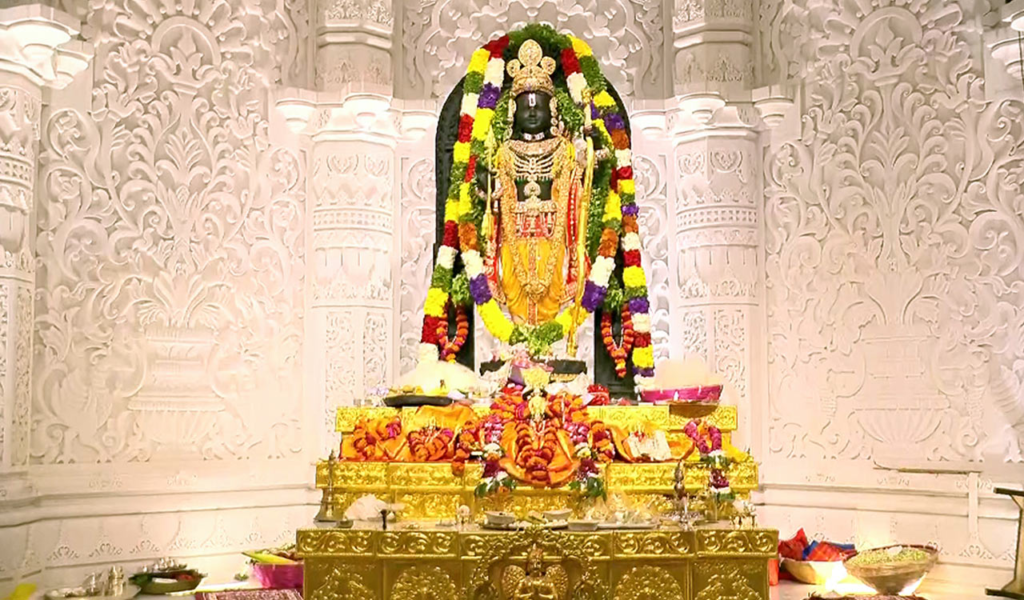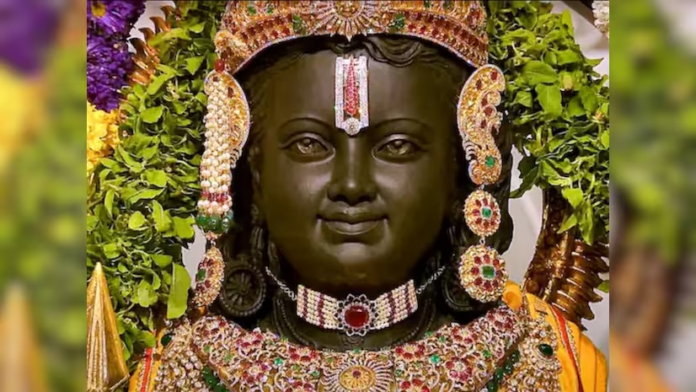Ram Lalla Surya Tilak: This year’s Ram Navami is going to be special in many ways. This is the first Navratri after the consecration of Ram temple in Ayodhya. Ram Mandir Tirtha Kshetra Trust has made special preparations for Ram Navami. On Ram Navami, on the day of Ram Janmotsav, Ramlala’s Surya Tilak will also be done. On April 17, at exactly 12:00 noon, Ram Lalla’s Surya Abhishek will be done. Special preparations have been made for this. The trial of Surya Tilak has also been successful. Let us know how Ram Lalla’s Surya Tilak will be done…
IIT Roorkee has designed a special optomechanical system
For Surya Tilak, IIT Roorkee Central Building Research Institute has designed a special optomechanical system. In this, the sun rays will fall on the mirror placed on the topmost floor (third floor) of the temple at exactly 12 noon. These rays will reflect at 90 degrees from the mirror and go into a brass pipe. There is a second mirror at the end of the pipe. The sun rays will reflect once again from this mirror and will turn at 90 degrees along with the brass pipe.
After being reflected for the second time, the sun rays will move downwards in a vertical direction. In this path of the rays, there will be three lenses one after the other, which will further increase their intensity. The pipe goes vertically. There is another mirror at the other end of the vertical pipe. The rays will fall on this mirror with increased intensity and will again turn at 90 degrees. These rays bent at 90 degrees will fall directly on Ram Lalla’s forehead. In this way, Ram Lalla’s Surya Tilak will be complete.
Sun rays will illuminate Ram Lalla’s face for four minutes
This tilak of sun rays will be 75 mm in circular form. The sun rays will fall on Ram Lalla’s forehead at 12 noon. The rays will illuminate Ram Lalla’s face for four minutes continuously. Ram Mandir Trust’s general secretary Champat Rai said that the preparations for applying sun tilak to Shri Ram Lalla are being done with utmost hard work. It is possible that the efforts of the scientists will bear fruit on Ram Navami. It will be telecast live through nearly 100 LED screens.
Gears will change the speed of the rays in seconds
19 gears have been installed in this system to ensure that Surya Tilak takes place on time. These gears will change the speed of the rays on the mirror and lens in seconds. This entire system will work without electricity.
The result of their hard work is that
in the construction of the special ‘Surya Tilak’, technical help regarding the path of the sun has been taken from the Indian Institute of Astrophysics (IIA), Bangalore. Rajendra Kotariya, MD of Bangalore-based company Optica, has prepared the lens and the gas tube. He also installed it. The CBRI team is led by Dr. SK Panigrahi along with Dr. RS Visht, Kanti Lal Solanki, V Chakradhar, Dinesh and Sameer.

Surya Tilak is also being done in these temples
The Surya Tilak mechanism is already being used in some Jain temples and the Sun Temple of Konark. However, different types of engineering have been used in them.
The mechanism is the same in the Ram temple, but the engineering is completely different. Doing the Tilak at the scheduled time was a big challenge.
Jain Temple of Gujarat

Surya Tilak also takes place at Koba Jain Tirtha located in Ahmedabad, the capital of Gujarat. Koba is known for having a huge collection on ancient Jain texts. It has also received the Certificate of Excellence from the Golden Book of World Records. This temple in Ahmedabad has been built in such a way that there is a confluence of Jainism and science. Here every year on May 22, in the presence of lakhs of Jains, the sun casts its rays on the forehead of Shri Mahavir Swami Bhagwan. This unique event lasts for about three minutes.
The trustee of Koba Jain Aradhana Kendra says, ‘Every year since 1987, Surya Tilak takes place on 22nd May at 2.07 pm. Till date, clouds have not been seen obstructing the sun rays at this time. The trustee also says that there is no magic, but such Surya Tilak has been possible due to the skillful construction of the temple with the correct use of traditional knowledge of mathematics, astronomy and sculpture.’
Mahalakshmi Temple’s famous Kiron Festival

The Mahalakshmi temple located in Kolhapur, Maharashtra is famous for Kiranotsav. This temple was built by Karnadev, a ruler of the 7th century Chalukya dynasty. The rare Kiranotsav event occurs in the temple when the rays of the sun fall directly on the idol of the goddess. This happens twice a year. On 31 January and 9 November, the rays of the sun fall on the feet of the mother. On 1 February and 10 November, the rays of the sun fall on the central part of the Rashmi idol. On 2 February and 11 November, the rays of the sun bathe the entire idol with their light. This amazing event is live streamed through LED screens. The festival of sun rays is celebrated with great enthusiasm in the Mahalakshmi temple.
Balaji Sun Temple of Datia

An incident related to sun rays takes place in Unav Balaji Sun Temple located in Datia, Madhya Pradesh. This is a very old temple located 17 km away from Datia. It is believed that the Sun Temple is from pre-historic times. The first ray of the sun at this Sun Temple located in the hills falls directly on the idol located in the sanctum sanctorum of the temple.
Sun Temple in Modhera, Gujarat

The Sun Temple is located in Modhera village, about 25 km from Mehsana. According to the Archaeological Survey of India, the temple was built in 1026-27 AD during the reign of Bhima I of the Chaulukya dynasty. The temple was built in such a way that on 21 March and 21 September the sun rays would directly enter the temple and fall on the Sun idol. The temple is today a protected monument maintained by the Archaeological Survey of India.
Sun Temple at Konark

Konark Sun Temple located in Odisha is famous all over the world for its architecture. Konark has a huge temple dedicated to the Sun God. King Narasimhadeva I, the great ruler of the Ganga dynasty, built this temple in the mid-13th century.
This temple is considered an architectural marvel of eastern India and a symbol of India’s heritage. Its architecture is such that the first ray of the sun falls on the main entrance of the temple. Then the sunlight enters the temple through its various doors and illuminates the sanctum sanctorum.
Ranakpur Temple in Rajasthan

Located about 90 km from Udaipur city in Pali district, Rajasthan’s Ranakpur Temple is situated on the banks of the Maghai River. Hidden in the forests of the Aravalli Hills, Ranakpur is a magnificent place in the form of a 15th-century Jain temple. The Ranakpur temple is also the largest and most important place of worship for Jains. Sunlight enters the temple and illuminates the inside of the temple. The architecture of the temple is such that the rays of the sun fall on the idol of the Sun God during the day.
Gavi Gangadhareshwara Temple in Bangalore

Gavi Gangadhareshwara Temple is one of the most famous temples in Bangalore. It is also known as Gavipuram Cave Temple. This temple dedicated to Lord Shiva exhibits amazing architecture. Lakhs of devotees visit this temple every year. The inner sanctum of this cave temple is carved in a special rock. Because of this, direct sunlight reaches the temple. This happens every year in a special month, on a special day. On this day, the rays of the sun reach the sanctum sanctorum of the temple in a magical way. The statue of Nandi is first illuminated by the rays and then the feet of the Shivalinga are touched and finally it illuminates the entire Shivalinga. The festival of Makar Sankranti is celebrated on this day. During this, the priests recite holy verses. Lord Shiva is bathed with milk, to see which thousands of devotees come to the temple to seek the blessings of the Lord.

